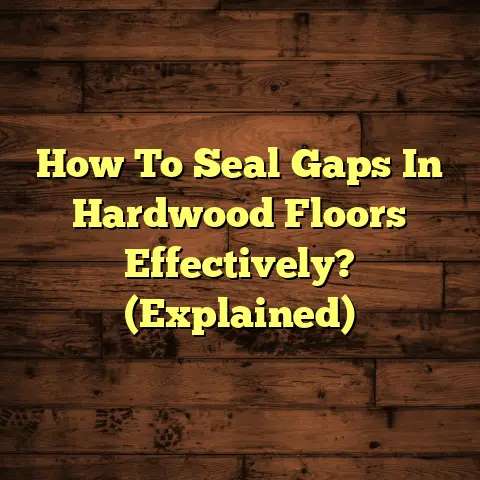Engineered Hardwood Cost? (Avoid These 3 Traps!)
Engineered hardwood flooring is often touted as the best of both worlds—combining the beauty of natural wood with enhanced durability and affordability.
Yet, as homeowners embark on the journey to transform their spaces, they often find themselves ensnared in a web of hidden costs and unforeseen pitfalls.
How can something so appealing lead to such
confusion?
I see this happen all the time as a
flooring contractor.
Let’s dive into the
realities of engineered hardwood costs and how
to avoid some common traps.
Section 1: Understanding Engineered Hardwood
Definition and Composition
So, what exactly is engineered hardwood?
It’s not solid wood all the way through.
Instead,
it’s made of layers.
The top layer is a veneer
of real hardwood – this is what you see and feel.
Underneath, there are multiple layers of plywood
or high-density fiberboard (HDF) that are bonded
together.
Think of it like a multi-layered cake, where the top layer is the delicious frosting (the hardwood veneer) and the layers beneath provide stability and structure.
These core layers are usually made of softwood
or hardwood, but the key is that they are
specifically designed to resist moisture and
warping.
This construction is what gives
engineered hardwood its stability.
Market Appeal
Why are so many homeowners drawn to engineered hardwood?
Well, it’s got a lot going for it.
First, it
looks like real hardwood.
You get the natural
grain patterns, the warmth, and the beauty that
only real wood can provide.
Second, it’s more versatile than solid hardwood.
Because of its construction, engineered hardwood
can be installed in places where solid hardwood
might not be suitable, like basements or over
concrete slabs.
Third, and perhaps most importantly, it can be
more affordable than solid hardwood.
I say “can” because, as we’ll see, that’s not
always the case.
Comparative Cost Analysis
Let’s talk numbers. What can you expect to pay for engineered hardwood?
Generally, engineered hardwood ranges from
$3 to $15 per square foot for the materials
alone.
Solid hardwood, on the other hand,
typically starts around $8 per square foot and
can easily exceed $20.
Here’s a quick breakdown of factors affecting price:
- Veneer Thickness: A thicker veneer means a higher price, but also a longer lifespan because it can be sanded and refinished.
- Core Material: HDF cores tend to be less expensive than plywood cores.
- Finish: Factory-finished floors are usually more expensive upfront but can save you money on installation.
- Brand: Just like with anything else, well-known brands often come with a premium.
- Width and Length: Wider planks and longer lengths can also increase the price due to increased material usage and manufacturing complexity.
Table: Engineered Hardwood vs. Solid Hardwood Cost Comparison
These prices are estimates and can vary based on location, brand, and specific product.
Keep in mind that these are just averages.
The
actual price you pay will depend on a lot of
different factors.
Section 2: The Benefits of Engineered Hardwood
Durability and Stability
One of the biggest advantages of engineered hardwood is its stability.
Because of its layered construction, it’s less
susceptible to expansion and contraction due to
changes in humidity and temperature.
This makes
it a great choice for climates with significant
seasonal changes.
I’ve seen solid hardwood floors buckle and warp
in homes with high humidity, but engineered
hardwood tends to hold up much better.
It’s not
waterproof, mind you, but it’s definitely more
moisture-resistant than solid wood.
Installation and Maintenance Costs
Installation costs for engineered hardwood can be
lower than solid hardwood, especially if you
choose a click-lock system.
These systems are
designed for easy, DIY installation.
However, even with a click-lock system, proper
subfloor preparation is crucial.
If your
subfloor is uneven or damaged, you’ll need to
fix it before installing the new floor.
This can
add to the overall cost.
Maintenance is also relatively straightforward.
Regular sweeping and occasional mopping with a
wood floor cleaner are usually all that’s needed.
Unlike solid hardwood, engineered hardwood can
only be refinished a limited number of times,
depending on the thickness of the veneer.
Thinner
veneers might not be able to be refinished at
all.
Environmental Impact
If you’re concerned about the environment,
engineered hardwood can be a good choice.
Many
manufacturers use sustainable sourcing practices
and offer products that are certified by
organizations like the Forest Stewardship Council
(FSC).
Because engineered hardwood uses a thinner layer
of real wood, it requires fewer trees to be
harvested than solid hardwood.
Plus, the core
layers can often be made from recycled wood
fibers.
However, it’s important to do your research and choose a product from a reputable manufacturer that is committed to sustainability.
Section 3: The Three Traps to Avoid
Now, let’s get to the heart of the matter: the three traps that can turn your engineered hardwood dream into a costly nightmare.
Trap 1: Underestimating Installation Costs
This is a big one.
Many homeowners assume that
because engineered hardwood is “easier” to
install than solid hardwood, the installation
costs will be minimal.
That’s not always the case.
Here are some factors that can drive up installation costs:
- Subfloor Preparation: As I mentioned
earlier, a properly prepared subfloor is
essential.
If your subfloor needs to be leveled, repaired, or replaced, that will add to the cost. - Labor Costs: Even with a click-lock
system, installation can be time-consuming
and require specialized tools.
Hiring a professional installer can be expensive, but it’s often worth it to ensure a proper installation.
According to HomeAdvisor, the average cost to install engineered wood floors ranges from $3 to $8 per square foot for labor.
HomeAdvisor Link - Removal of Old Flooring: Removing old
carpet, tile, or hardwood can be a messy and
labor-intensive process.
Some installers charge extra for this service. - Trim and Moldings: You’ll likely need to
install new trim and moldings to cover the
edges of the floor.
This can add to the overall cost. - Unexpected Issues: Sometimes, unexpected
problems arise during installation, such as
hidden plumbing or electrical issues.
These problems can add to the cost and delay the project.
I remember one homeowner who thought he could
save money by installing engineered hardwood
himself.
He quickly realized that he was in over
his head when he discovered that his subfloor was
severely uneven.
He ended up having to hire a
professional to fix the subfloor, which cost him
more than he would have paid to have the entire
floor professionally installed in the first place.
Real-World Example:
A client of mine in Austin, Texas, recently
decided to install engineered hardwood in her
living room.
She got a great deal on the flooring
itself, but she didn’t factor in the cost of
removing the old tile floor.
It turned out that
the tile was bonded very tightly to the subfloor,
and it took a team of professionals an entire day
to remove it.
The removal cost ended up being
nearly as much as the cost of the new flooring!
Trap 2: Overlooking Quality vs. Price
In the world of engineered hardwood, you get what you pay for.
Cheap engineered hardwood might seem like a great deal upfront, but it can end up costing you more in the long run.
Here’s why:
- Thin Veneer: Cheap engineered hardwood
often has a very thin veneer of real wood.
This means that it can’t be sanded or refinished, and it’s more susceptible to scratches and dents. - Poor Core Material: The core layers of cheap engineered hardwood might be made from low-quality materials that are prone to warping and swelling.
- Weak Finish: The finish on cheap
engineered hardwood might not be as durable
as the finish on higher-quality products.
This means that it will wear down more quickly and require more frequent maintenance. - Inconsistent Manufacturing: Cheap engineered hardwood might be manufactured with less precision, resulting in uneven planks and gaps between the boards.
I’ve seen homeowners install cheap engineered
hardwood only to have it start peeling and
delaminating within a few years.
They then have
to replace the entire floor, which ends up costing
them far more than if they had invested in a
higher-quality product from the start.
Testimonial:
“I went with the cheapest engineered hardwood I
could find to save money on my basement remodel.
Big mistake!
Within a year, the finish started
wearing off in high-traffic areas, and the boards
started separating.
Now I have to replace the
whole thing.
I learned my lesson: you get what you
pay for!” – Sarah J., Denver, CO
Case Study:
A study by the National Wood Flooring Association (NWFA) found that homeowners who purchased high-quality engineered hardwood flooring were more likely to be satisfied with their investment and less likely to experience problems such as warping, peeling, and delamination.
Trap 3: Ignoring the Long-Term Value
Finally, many homeowners focus solely on the upfront costs of engineered hardwood without considering the long-term value.
While it’s important to stay within your budget, it’s also important to think about how the flooring will affect the value of your home and your enjoyment of the space over time.
Here are some factors to consider:
- Resale Value: Engineered hardwood can
increase the resale value of your home,
especially if it’s installed in a high-
traffic area like the living room or kitchen.
According to a study by Realtor.com, homes with hardwood floors tend to sell for more than homes with carpet or vinyl flooring. - Durability: A durable floor that will last for many years is a better investment than a cheap floor that will need to be replaced in a few years.
- Aesthetics: A beautiful floor can enhance the overall look and feel of your home, making it a more enjoyable place to live.
- Maintenance: A floor that is easy to clean and maintain will save you time and money in the long run.
I’ve seen homes with outdated or damaged flooring sit on the market for months, while homes with beautiful, well-maintained engineered hardwood floors sell quickly and for top dollar.
Statistical Data:
According to the National Association of Realtors, 54% of buyers are willing to pay more for a home with hardwood flooring.
Table: Long-Term Value Factors
Section 4: Conclusion
Engineered hardwood can be a fantastic flooring
choice, offering a blend of beauty, durability,
and affordability.
However, it’s crucial to go
into the process with your eyes wide open.
Don’t fall into the traps of underestimating installation costs, overlooking quality in favor of price, or ignoring the long-term value.
By doing your research, working with a reputable installer, and choosing a high-quality product, you can ensure that your engineered hardwood flooring project is a success.
Remember, a little bit of planning and preparation can save you a lot of headaches (and money) in the long run.





